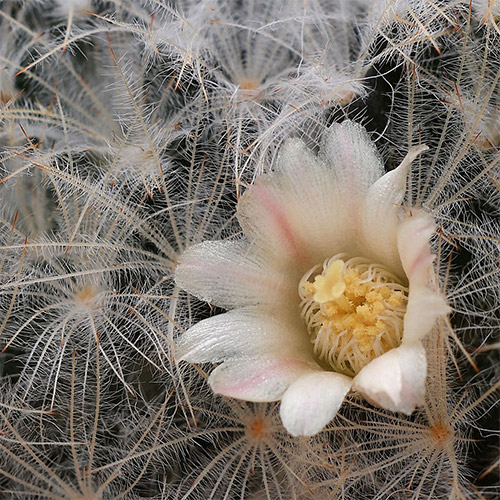📷 Dornenwolf, wikimedia.org
Mammillaria plumosa aka 🪶Feather 🌵Cactus
Mammillaria | Updated: February 15, 2025
The white feathers on Mammillaria plumosa look soft and fluffy, but they hide the sharp spines that cover this cactus. The feathers not only add interest to the cactus, but they also shade the plant from heat and sun.
Quick Guide
- Full sun to partial shade 🌤️
- Typical water needs for a succulent
- Plant grows up to 3″ (8 cm) tall
- Plant grows up to 16″ (40.6 cm) wide
- Zone 9a (Minimum 20° F | -6.7° C)
- Not cold hardy
- Propagation by cuttings, offsets, and seeds
- Generally non-toxic to humans and animals
- Winter Dormant
How to 🩷 Care for and Propagate Your 🪴 Succulents
General Care for Mammillaria plumosa aka Feather Cactus
Mammillaria plumosa, commonly known as Feather Cactus, thrives in container gardens, showcasing flowers that range from white to yellow to pink. While it can bloom throughout the year in certain climates, its main flowering period is in Spring.
This species is categorized as near threatened.
Watering
Feather Cactus requires typical succulent watering practices. Employ the soak and dry method, allowing the soil to completely dry out between waterings.
Where to Plant
Due to its lack of cold hardiness, plant Mammillaria plumosa in containers that can be moved indoors if your area experiences temperatures below 20°F (-6.7°C). It prefers full to partial sun.
Select a garden location that receives at least 6 hours of sunlight daily. For indoor placement, position near a southern-facing window to ensure ample sunlight (Northern Hemisphere).
How to Propagate Mammillaria plumosa aka Feather Cactus
Propagation of Feather Cactus can be achieved through cuttings, offsets, or seeds.
Cuttings
Take a stem cutting using sterile scissors or a knife. Allow the cut end to callous over for several days before planting in well-draining soil. Water when the soil has completely dried out.
Offsets
The plant naturally produces offsets around its base. Carefully detach these offsets from the main stem and let them dry for a day or two before replanting in well-draining soil.
Seeds
Harvest seeds from ripe fruit. Clean and dry the seeds thoroughly before sowing in well-draining soil. Outdoor planting is suitable for zones above 9a, while cooler regions may require indoor starting under grow lights or on seed mats.
Tags & Attributes
Scientific Classification
Kingdom: Plantae
Clade: Tracheophytes
Clade: Angiosperms
Clade: Eudicots
Order: Caryophyllales
Family: Cactaceae
Subfamily: Cactoideae
Genus: Mammillaria
Species: M. plumosa



